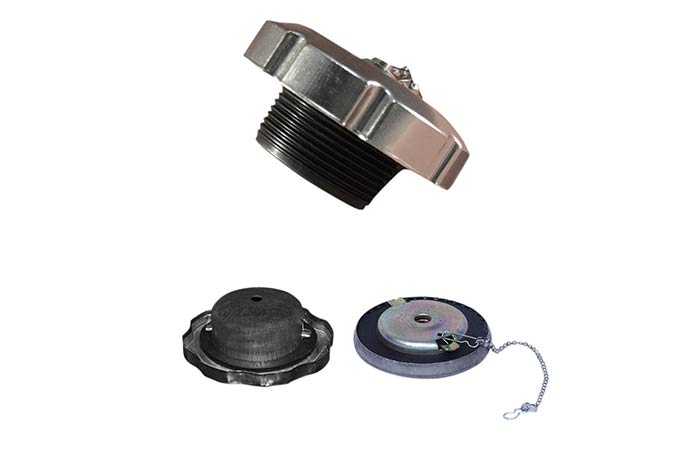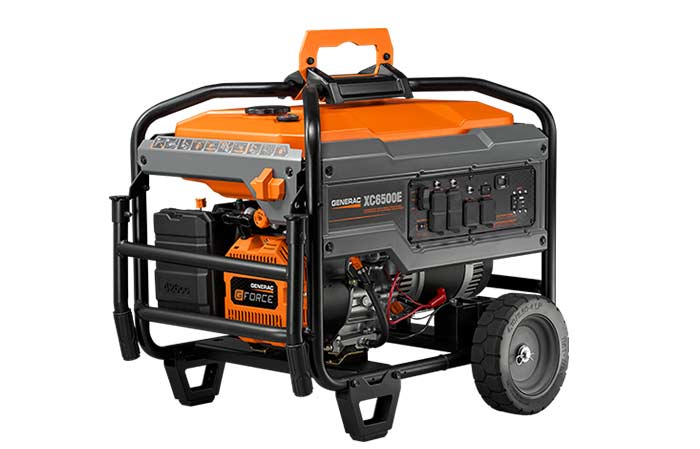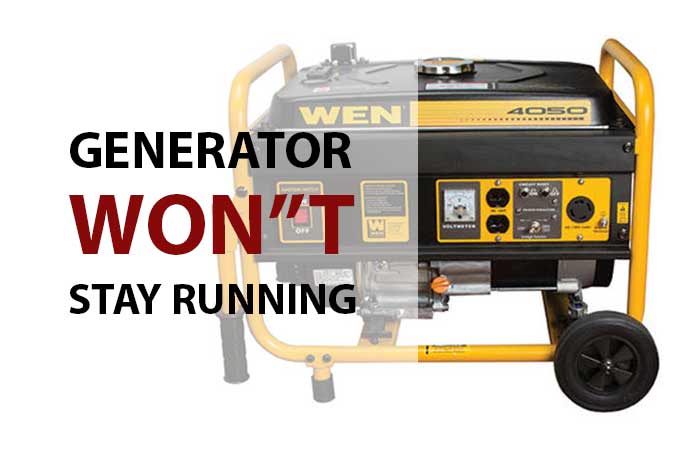A normal generator should start quickly, run smoothly and go off when turned off or when it runs out of fuel. In some cases, however, the generator may start well but shuts itself off after running for a few minutes. This can occur either immediately you start the generator or after running it for a while; like 20 minutes. It may also occur the moment you plug in the power output This is quite frustrating given that it’ll be cutting off the power supply to the house or any other outdoor appliances.
A generator may not stay running because of an overload, insufficient fuel, clogged fuel cap and carburetor amongst other mechanical issues. Depending on the scenario in which the generator shuts itself off, the causes can be different with some quite easy to fix.
In this guide, we detail all the possible causes of this issue and their respective solutions. For the best results, you’ll need to have your generator’s manual on hand to identify some parts and procedures we may mention. If, however, you already have experience with the generator, you’re good to go.
What causes a Generator Run then Shut off?
Some of the reasons your generator won’t stay running include the following:
1. Overload
The safest way to start and use a generator for power generation or other task is to start it, let the roar become smooth then connect the load. If you try starting the generator without the load connected, it’ll likely not start. This occurs even when the load is within the capabilities of the generator.
On the other hand, if the generator shuts itself off when you connect the load, it means that your overloading it. Chances are that the number of electronics drawing power from generator add up to more than what the generator can produce.
Solution
Disconnect some electronics from the power then try again. If the generator doesn’t shut off by itself like before. The problem would be an overload.
When buying a generator for your home or other activity, always calculate the amount of power you’ll be needing then buy about 1.5 times the output. This ensures that even when you increase the power use, your needs will still fall within the generator’s load.
Further Reading: How deal with and Overloaded Generator
2. Low fuel level
Another simple reason could be that the generator has run out of fuel while running. The amount of fuel needed to start the generator is quite low compared to that needed to run it. As such, your generator can start but runs out of fuel. If you didn’t check the fuel level or didn’t just refuel before starting it, this is likely one of the reasons.
Solution
The solution to low fuel is adding fuel to the fuel tank. To be on the safe side, always check the amount of fuel in the generator before starting it. If the fuel is low, add in some up to the recommended level. Don’t fill the tank until it overflows as it is a major fire risk. Also, only add fuel to the tank when the generator is cold. If it’s still hot from running, wait till it cools down first.
3. Clogged fuel cap
Fuel flows from the tank to the carburetor and the other parts of the generator engine by gravity. As it flows out of the tank, it leaves space which is taken up by air from outside. This air flows through a hole in the fuel cap.

If the fuel cap is closed too tightly or the small vent is clogged up, air wont flow into the tank to take up the space left by the used-up fuel. In such a case, a vapor lock (vacuum) forms in the tank and prevents the flow of fuel out of it. the generator won’t get fuel to run on and will thus shut down after a while.
Solution
If this occurs, try loosening the fuel cap then running the engine again. At all times, make sure the little vent on the fuel cap is always open. You can unclog it with a needle. Your generator should run without an issue after this.
4. Clogged carburetor
The carburetor has the role of mixing air and fuel in the right ratio before directing it to the piston chamber for combustion. If it gets clogged up, either air or fuel or both won’t reach the combustion chamber. In such a case, the generator won’t generate any power to keep it running and will simply shut down.
It can also be a case of having left the generator with fuel for a long time. The volatile ingredients in the fuel such as ethanol can evaporate and even absorb water in the air leading to clogging and stale fuel.
Solution
If this is the case, drain out all the stale fuel then add fresh fuel to the generator and try again running the engine. You should also remove the carburetor and float bowl, clean them and dry them before reinstalling them on the generator.
To prevent the recurrence of such an issue, always run the generator at least once a month to use up the stale fuel and prevent any sedimentation in the fuel. Also, add fresh fuel each time you’re running the generator. If fuel has been in a can for more than two months, it’ll already be stale and useless to your generator.
In the case that you left your generator without running for at least 2 months, simply drain the fuel and replace it with fresh petrol or diesel before starting it again.
5. Low water levels
If your Honda generator keeps shutting off, chances are that it doesn’t have enough coolant. Most large generators use water as a coolant which is poured into the radiator. if this water level is too low, the generator will automatically shut off to prevent damage to the delicate electronics. Most generators have a temperature gauge calibrated to a certain level above which the generator will shut down by itself.
Solution
Always check the water level in the carburetor before starting the engine. If the generator uses another coolant besides water, check that too and make sure it’s within the calibrated levels.
Keeping the generator aerated also helps it keep cool as air flowing through it carries away the excessive heat.
6. Fuel system problems
The fuel system is made up of the fuel tank and other parts such as the carburetor, fuel filter and others. These parts are interconnected with narrow pipes and small valves which can get damaged or clogged with time.
They can also easily get airlocked whenever there is an imbalance in the pressure in the fuel system. Bending can also block the pipes cutting of the supply if fuel. Leakages can also occur on the fuel system either in a valve or on the body of the pipe.
In all the scenarios described above, the carburetor and combustion chamber won’t be getting enough fuel and air to enable the generator run properly.
Solution
Checking the whole fuel system will help you identify the cause of the fuel problem and fix it accordingly. For leaks in valves and gaskets, replacing the valve or sealing it better can do the trick. On the other hand, a leaking pipe can be replaced or sealed to stop the leakage.
7. Engine failure
A more serious issue is when the engine fails and won’t continue running. This is a complex issue which must be addressed by a qualified professional since it can be quite hard to detect. This is usually an issue with old generators since new ones rarely have an engine failure.

Solution
The solution to this is simply calling in an expert especially from your generator’s manufacturer. If it’s a small and rectifiable issue, it’ll be solved with ease. if it’s a complex one which costs almost the price of a new generator, you’re better off getting a new generator.
8. Battery issues
While the battery to your generator is mainly used in starting it, it also supplies power to it and may shut off the generator if it’s not properly charged before using the generator. This can occur after the generator has run for a while and is usually an issue with the generator’s charging system.
In other times, the battery may be dead and the generator’s trials at charging it may be causing an electric issue.
Solution
If this problem persists, you should get your battery charged with an external source then reattach it to the generator. If the battery still doesn’t work, it’ll mean that it is dead and needs a replacement.
Preventing this issue is quite easy since you only need to start your generator using the switch (not the pull cord) at least once or twice every month. This helps discharge and recharge the battery thus keeping its parts in good condition.
9. Dirty or malfunctioning spark plug
The spark plug has the role of igniting the mixture of fuel and air to produce an explosion which then pushes the piston downwards. The motion of the piston then moves the rest of the engine leading to the production of power. This occurs in a looping series with the piston moving up to compress the air and fuel mixture followed by an ignition by the spark plug.
If the spark plug has dirt on the end needed to ignite the air/fuel mixture, it’ll not produce the spark and the whole combustion process will fail. The end result of this is the failure of the engine to continue running. This problem can occur at any time during the period the engine is running.
The other issue would be that the spark plug is malfunctioning. They can short-circuit and be unable to produce the needed spark.
Solution
Remove the spark plug from the generator then observe for dirt and any debris. Clean it in petrol using a knife to remove the stubborn debris. Let it dry before refitting it.
If this doesn’t work, check the spark plug by pulling the recoil starter while holding the spark plug’s end on the crankcase of the generator. The wire connecting to the end of the plug should still be intact to provide the needed electric charge.
If you notice a spark that’s blue in color, it means the plug is in good working condition. If the spark produced is weak or non-existent, it means the spark plug isn’t in good working condition. In the case of a weak or non-existent, simply buy a new plug and install it. Make sure it’s the same type (in terms of the voltage) to the one removed.
10. Clogged air filter
The generator’s air filter plays the all-important role of filtering air before directing to the carburetor where it mixes with fuel for ignition in the combustion chamber. With time, the impurities it catches in the air clog up its spongy element. If you’ve checked the fuel supply and it’s in good working, check the air filter next.
Solution
Open the generator’s air filter housing then check the element of the air filter (the spongy part) for clogs. Clean it with a soft brush and some light tapping. Don’t use water or any other liquid on this element. If the element is torn, buy a new air filter.
11. Wrong oil level
When your Champion generator runs then shuts off after a while, it could an issue with the oil level in the engine. This can occur whether the oil is too high or too low. Since oil is used both as a lubricant and coolant, if its temperature gets too high due to having too little oil in the engine, the generator is highly likely to shut itself off.
The generator runs by circulating oil in the moving parts. If there is too much oil in it, the circulation may not be smooth enough to properly lubricate the parts of the generator’s engine. In such a case, some parts of the generator will get too hot. To save them from getting damaged, the generator will shut itself off.
Solution
The solution to this is to wait until the generator has cooled down then check the level of oil in the engine. Ideally, it’s supposed to be between the MAX and MIN levels on the dipstick. If it’s higher than the MAX reading, drain some oil from the engine. If below the MAX reading, add some oil to the engine.
Further Reading
12. Problems in the electric circuitry
The generator can have issues with the wiring and flow of current from the battery to the parts which may lead to it shutting off. As observed in the above solutions, combustion in the combustion chamber only works when an electric current flows in the carburetor and ignites the mixture of fuel and air. If there is no current, there will be no ignition and the generator will simply shut itself down.
Solution
This one will need the skills and experience of a qualified expert to trace the flow of power from one component to the others to determine which ones aren’t passing current properly. In most cases, it may just be a wire or the connections inside the carburetor.
13. Choke in the wrong position
Your generator’s choke lever needs to be in the CLOSED/OFF position before you start the generator. As soon as the generator starts running, you’ll have to move it to the OPEN/ON position. If you forget to do this, the generator will run for a while then shut itself off.
Solution
This is a simple problem of remembering to turn the choke to the OPEN position when the generator is one. After shutting it down, move it to the CLOSED or OFF position.
14. Failing sensors
Modern generator models have lots of sensors for various measurements. If any one of them fails due to an electric shock, the generator may only run for a short while then stop. Always make sure that the sensors are in good condition and providing accurate indications before starting the generator.
Solution
This one will require the input of an expert to test each sensor and establish whether it’s in working condition or not. Equipment such as multimeters will be used and most people don’t store such in their homes.
15. Malfunctioning exhaust system
Upon combustion, the resulting smoke needs to be eliminated from the engine to make space for more smoke. It’s a continuous process which ensures the generator runs smoothly. In the case that the smoke created isn’t eliminated from the engine, the engine will shut down since it can’t burn any more fuel.
Solution
For such a case, you will observe the amount of smoke released is less than the usual one. If you have previous experience with the generator, you can follow up the exhaust system all the way to the combustion chamber to find out the issue then fix it accordingly. In some cases, it’s just a blockage in the system.
16. Clogged or closed fuel valve
The fuel valve controls the amount of fuel from the tank into the combustion chamber for combustion. If it’s not opened when running the generator, the engine will run out of fuel and shut down. While the valve should be in the OFF or CLOSED position when the engine is off, you should have it in the ON or OPEN position when running the engine.
While this is a small issue with petrol engines, diesel ones may require eliminating the air in the fuel system before restarting the generator. Until the air in the fuel system is eliminated, the diesel generator will not run or even start.
Other times, the fuel gauge might be clogged with dirt which prevents the flow of fuel to the combustion chamber.
Solution
If the generator shuts down due to the fuel gauge being closed, simply open it then run the engine again. If it’s a diesel engine, prime the air out at the fuel valve then restart the engine with the valve in the OPEN setting.
For a clogged fuel valve, you will need to remove it from the engine the clean it before reinstalling it.
Some of these issues can be quite difficult to detect especially when you don’t have experience using generators. The good news is that there are experts on the matter who can help out when it comes to the complex issues.
More Generator How-tos & Hacks
- Generator Won’t Start (New & Used): Causes, Troubleshooting & Fixes
- Generator Pull Cord Won’t Retract: Causes & Fixes
- How to Start a Generator: New, Used, With/Out Pull Cord
- Generator Running Rough & Not Smoothly-Causes + Fixes
- How to Connect /Hook Generator to House without Transfer Switch
- How to Clean Generator Air Filter & Housing
- How to make a Generator Quiet as a Cricket for Camping
- 15+ ways to Secure Portable Generators from Theft & Damage
- Portable Generators Safety Tips Checklist
- How to Make Generator Safe for Your Electronics
